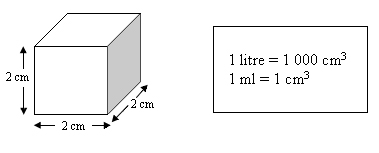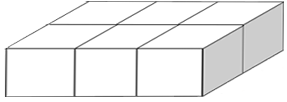Holding millilitres
This task is about volume and capacity.

| a) |
A plastic cube measures 2 cm by 2 cm by 2 cm. How many millilitres (ml) of water will it take to fill the cube?
(A) 2 (B) 3 (C) 6 (D) 8 (E) 16
(F) None of these. The cube will hold __________ millilitres.
|

[Not drawn to scale]
| b) |
An ice tray has 10 compartments. Each compartment measures 3 cm by 3 cm by 3 cm.
How many millilitres of water will it take to fill the ice tray?
(A) 9 (B) 27 (C) 37 (D) 90 (E) 270
(F) None of these. The ice tray will hold __________ millilitres.
|

[Not drawn to scale]
|
c)
|
A mould for home-made ice-blocks has 6 compartments. Each compartment measures 2 cm by 3 cm by 5 cm.
|
| i) |
How many millilitres of water will it take to fill the mould?
(A) 10 (B) 30 (C) 60 (D) 180 (E) 300
(F) None of these. The mould will hold __________ millilitres.
|
|
|
ii)
|
How many millilitres will be left from a full 1 litre jug after it has filled the mould?
__________ ml
|

